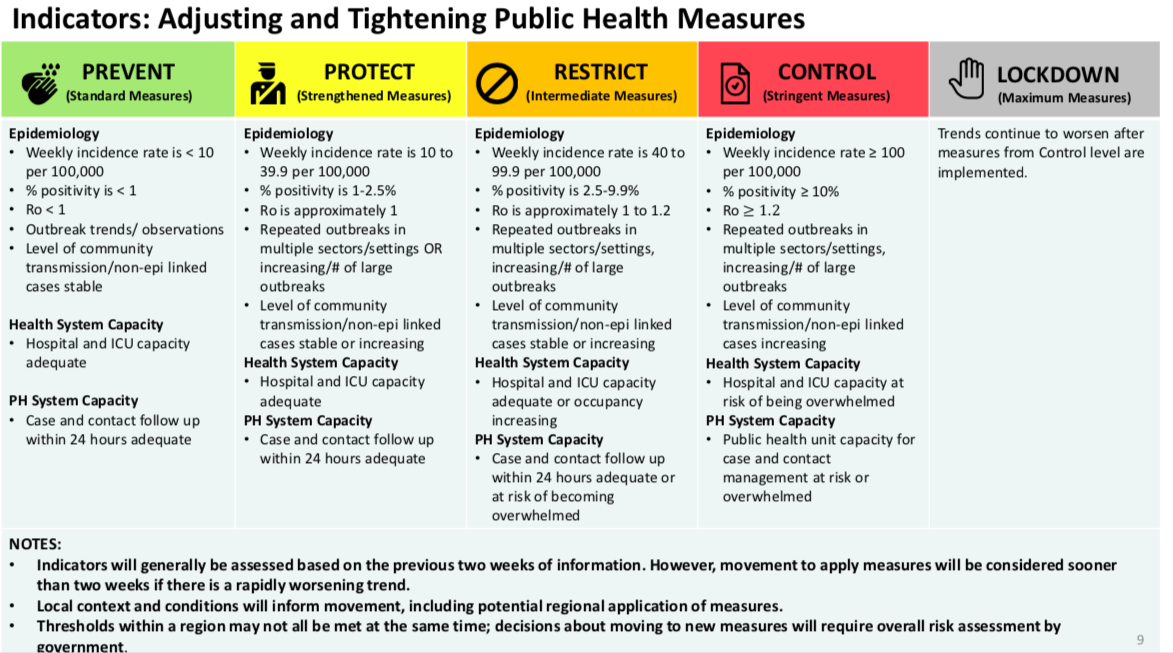Ontario allows COVID-19 hotspots to reopen with tighter restrictions, except for Toronto

Ontario Premier Doug Ford announced that COVID-19 hotspots can reopen with tighter restrictions on Saturday, November 7, except for Toronto.
On Tuesday, Ford said York Region, Peel, and Ottawa will be able to reopen gyms, indoor dining, cinemas, and other spaces but with tighter restrictions. However, Toronto will not be able to move into the next stage until November 14, at the request of Mayor John Tory.
Toronto has been continually reporting over 300 new cases daily for some time.
This announcement comes with the province’s release of the Keeping Ontario Safe and Open Framework which wants to ensure there is a limit of transmission of the virus, avoid closures, keep schools and childcare open, maintain healthcare and public health system capacity, protect vulnerable populations, and provide additional supports where possible.
The province has come up with five categories that each have their distinct guidelines to help stop the spread of the virus. The five categories include: prevent (green); protect (yellow); restrict (orange); control (red); and lockdown (grey).

Government of Ontario
“It’s clear COVID-19 will be with us for a while, which is why we are putting in place a framework that will protect the health and safety of individuals and families while avoiding broader closures across the province,” said Ford.
“This framework, developed in consultation with our health experts, will serve as an early warning system allowing us to scale up and scale back public health restrictions on a regional or community basis in response to surges and waves of COVID-19. By introducing public health measures sooner, we can keep this deadly virus at bay, bend the curve and reclaim a little more of our normal lives.”
In the protect level is Brant County Health Unit, Hamilton, Durham, and Halton Region.
All the other regions are in the prevent level.

Government of Ontario
There are now specific guidelines for each level when it comes to gatherings, food and drink establishments, sports and recreational fitness, event spaces, retail, personal care services, casinos, cinemas, and performing arts spaces.
According to the province, the framework takes a gradual approach that includes introducing preventative measures earlier to help avoid broader closures and allow for additional public health and workplace safety measures to be introduced or removed incrementally.
For all regions to be at the prevent level, they need to have an incidence rate of less than 10 per 100,000 and a positivity rate of less than 1%.
The reproductive number needs to be less than 1 with the level of community transmission stable.
At the restrict level, the incidence rates need to be 40 to 99.9 people per 100,000 with a positivity rate of 2.5 to 9.9%. The reproductive numbers need to be 1.0 to 1.2 with the level of community transmission stable or increasing.
“As the province continues to expand access to real-time data, enhancements are also being made to Ontario.ca/coronavirus, Ontario’s one-stop shop for information on COVID-19. Information about the spread of the virus, and public health and health system capacity will now be available on the website,” the release notes.
This includes local cases by public health unit regions, the total number of cases, resolved cases, deaths, tests completed, and how many are positive.
“The province will continue to add data sets as they become available, such as sources of outbreaks as a subset of overall cases. This information will better help businesses, organizations and local communities access key information to prepare in advance for any changes in their region,” the province says.

Government of Ontario
Final decisions on moving public health unit regions into the framework will be made by the government based on updated data and in consultation with the Chief Medical Officer of Health, local medical officers of health, and other health experts, and will be reviewed weekly.
On Tuesday, the province reported it’s highest single-day coronavirus cases with 1,050 cases.

